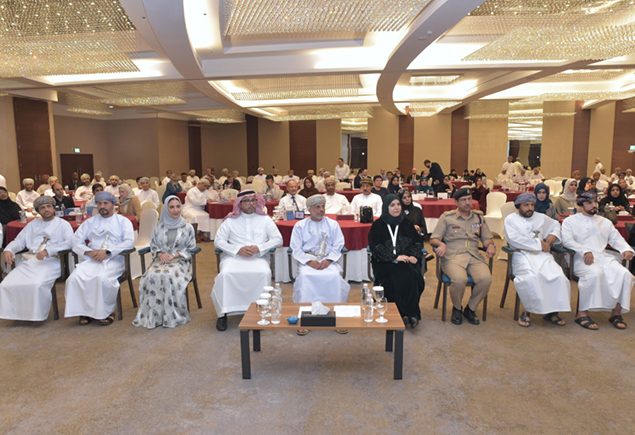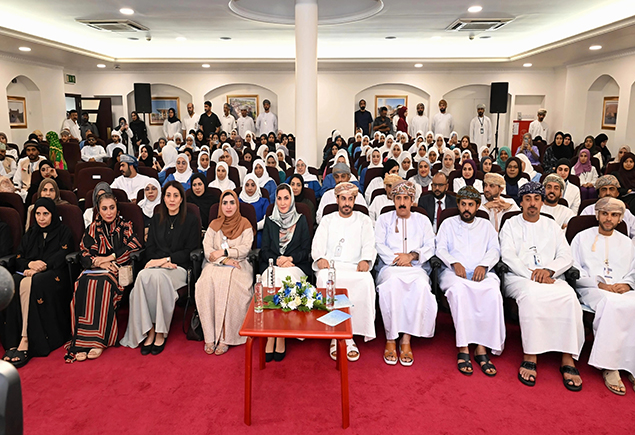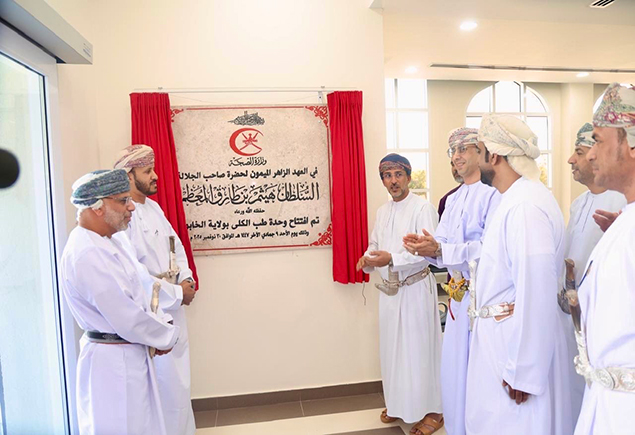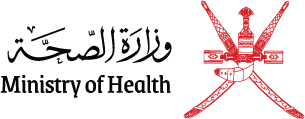The Ministry of Health (MOH), represented by the Center for Disease Control and Prevention, celebrated today (Sunday) the official launch of the Latent Tuberculosis Screening and Treatment Project as part of the Medical Fitness Screening Program in Oman, under the title “Oman Provides an Opportunity to End Tuberculosis” at the InterCity Hotel in Al Khuwair.
The event was held under the auspices of H.E. Dr. Said bin Harib Al-Lamki, MOH Undersecretary for Health Affairs, with the attendance of H.E. Suleiman Al-Dakhil, Director-General of the Health Council of the Gulf Cooperation Council.
H.E. Dr. Said bin Harib Al-Lamki, MOH Undersecretary for Health Affairs, reviewed the progress of the project and its achievements, such as expanding universal health coverage in Oman and the strategy to eliminate tuberculosis. He also highlighted future plans to expand the program.
On his part, H.E. Suleiman Al-Dukhail, Director-General of the Gulf Health Council, presented a detailed overview of the 'Wafid' program, highlighting its concept, objectives, key stakeholders, the program's online portal, and electronic connectivity with Gulf Cooperation Council countries, among other aspects.
Dr. Amal Al-Maani, MOH Director-General of the Center for Disease Control and Prevention emphasized that the project was the result of a comprehensive study of the epidemiological situation of tuberculosis in Oman. She revealed that most active tuberculosis cases are imported, primarily coming through migrant workers. Therefore, this project is a response to enhance health security in Oman and expand the scope of preventive healthcare to ensure the well-being of the community in all its segments.
Al-Maani indicated that this project not only reflects a new step in the fight against tuberculosis but also represents a living example of effective partnership between the public and private sectors. It embodies cooperation between government authorities, the private sector, and international organizations, not only within Oman but also at the regional and international levels, to achieve public health goals and tackle infectious diseases through the implementation of digital health systems. The project contributes to improving diagnosis and treatment, increasing universal health coverage to make it more effective and inclusive. These systems enable the accurate and rapid tracking of health cases, helping to reduce the spread of the disease and ensure early treatment.
Eliminating tuberculosis is one of the most prominent global public health projects and a key goal of sustainable development. The program aligns with the objectives of Oman Vision 2040, which aims to strengthen a preventive healthcare system to build a healthy society.
The project was implemented by Qiagen; it is an integrated electronic system that connects various sectors within and outside the Ministry of Health to achieve integration between them and enhance efficiency and speed in executing procedures. This includes partnerships with the private sector for verifying the identity of migrants using fingerprinting and photographs, as well as collecting blood samples and transporting them to government laboratories.
The system also directly links laboratory-testing devices to both private and public screening centers for various infectious diseases, including tuberculosis, to ensure accurate and rapid diagnosis and governance. In addition, it integrates with relevant external entities, both within Oman and abroad, to ensure the accuracy of data, such as the electronic portal of Sand Centers, the Ministry of Commerce, Industry, and Investment Promotion, the Ministry of Transport, Communications, and Information Technology for electronic authentication, and the Royal Oman Police for residency verification.
Furthermore, the devices were externally connected to the Medical Wafid System of the Gulf Cooperation Council to ensure alignment of tuberculosis screening and treatment policies between the GCC countries and to enhance health monitoring of migrants.
To ensure its success, the 'IGRA' test was adopted in this program for diagnosing latent tuberculosis. This highly sensitive and accurate test involves collecting a blood sample, which is analyzed using advanced devices capable of processing over 100 blood samples daily. This facilitates and accelerates the screening process, ensuring early and effective detection of latent cases before they develop into active disease.
The launch was followed by a training workshop attended by 200 participants, including doctors, nurses, technicians, and key points of contact for the Latent Tuberculosis Screening and Treatment Program across various governorates of Oman, as well as from the Military and Security Medical City, the University Medical City, and the Royal Oman Police Hospital. During the workshop, speakers from the Ministry of Health and the implementing company delivered lectures.
It is worth mentioning that tuberculosis remains a global health challenge, with reports from the World Health Organization indicating that approximately 10.8 million people were diagnosed with tuberculosis in 2023, the highest recorded number since global monitoring began in 1995. Despite a decrease in the number of tuberculosis-related deaths from 1.32 million in 2022 to 1.25 million in 2023, the disease has once again become the leading cause of infectious disease-related deaths worldwide. Estimates also suggest that a quarter of the world's population is infected with latent tuberculosis
At the local level, Oman is one of the countries with a low tuberculosis incidence rate, with the rate standing at 8.0 per 100,000 population in 2023. This increase is attributed to the higher incidence rate among non-Omani individuals, who represent the majority of reported cases. Among Omanis, however, the incidence rate has remained stable since 2018. In 2024, 419 cases of tuberculosis were recorded, including 331 cases among non-Omanis, along with 18 deaths and 3 cases of drug-resistant tuberculosis.
As part of its efforts to combat tuberculosis, the Sultanate of Oman launched the National Tuberculosis Elimination Strategy on March 24, 2021, aiming to reduce the incidence to less than 100 cases per million people by 2035, with a focus on prevention, diagnosis, treatment, and strengthening efforts. The Latent Tuberculosis Screening and Treatment Program is a key component of this strategy, targeting high-risk groups, such as those in contact with tuberculosis cases and individuals coming from countries with high infection rates, to prevent the progression of latent infections into active disease and reduce the spread of tuberculosis in the community.







